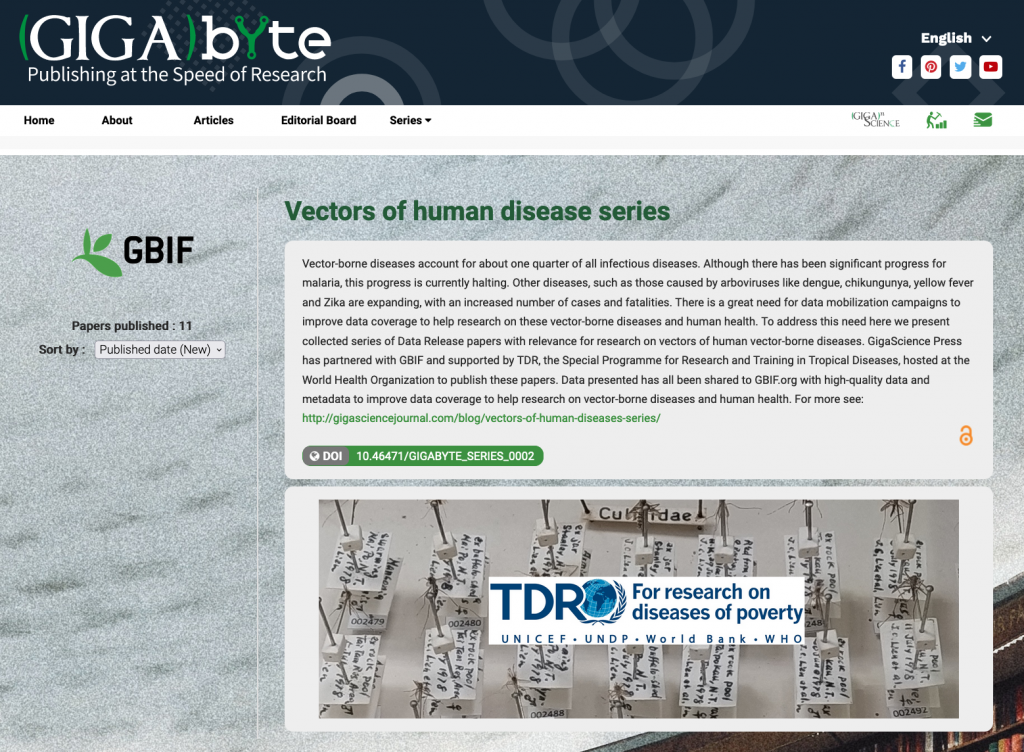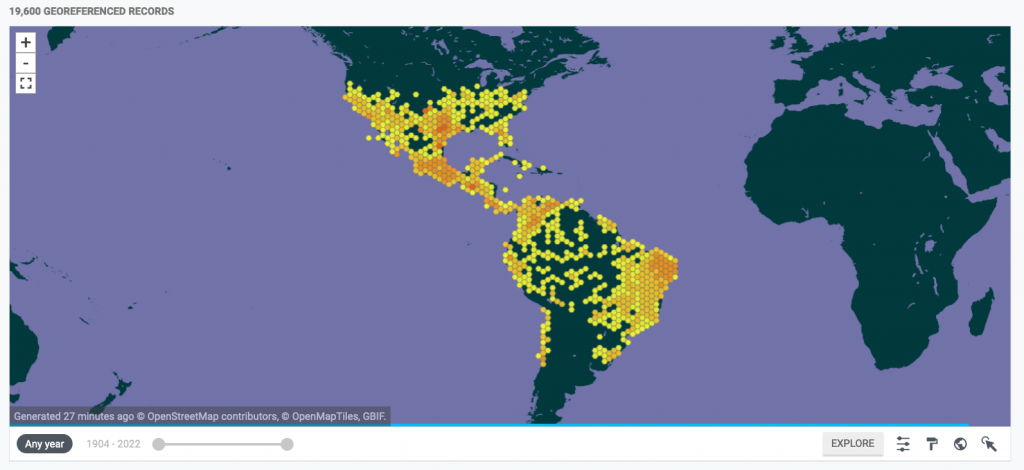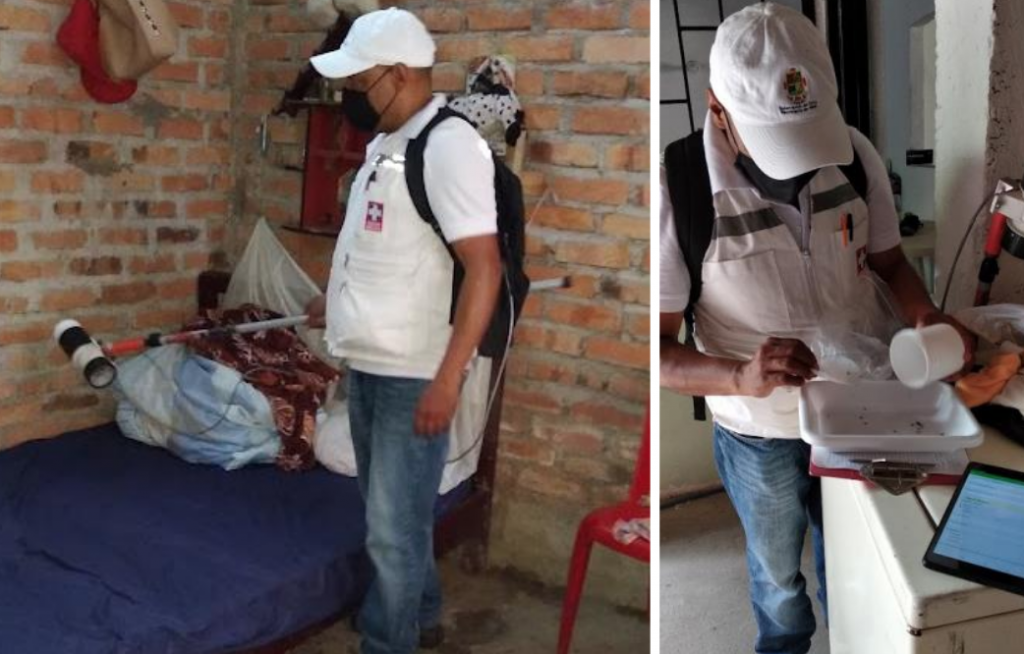GigaByte helping the fight against Vector-Borne diseases with data

Our WHO-sponsored series of articles describing biodiversity data relevant to vector-borne diseases has now been published in GigaByte. This special issue presents a wide variety of data relating to the presence, spread, and diversity of organisms that are transmitting viruses, bacteria and parasites to humans. The biodiversity data described in these articles provides researchers with information to aid in the battle against this prevalent and growing burden on the health of millions of people worldwide. Further, the work here incentivises data sharing through the GBIF.org platform to track and assess particular species, most especially in geographic gaps where the presence and expansion of these organisms are not well described. As the world continues to see the spread of disease vector species and new vector-borne diseases, the collection of monitoring data, coupled with sharing of and open access to such data to enable analysis, are part of the frontline to battle such scourges.
Vector-borne diseases are responsible for more than 17% of infectious diseases. Debilitating and deadly diseases, such as malaria, dengue, chikungunya, yellow fever and zika, can only be contained by having the latest and most abundant amount of information on the presence, diversity, ecology, bionomics and geographic spread of the organisms that carry and transmit the infectious agents. There are, however, huge gaps in the information related to these vectors, and data mobilisation and sharing campaigns are essential to combat these scourges.
As part of these efforts, GigaScience Press partnered with the Global Biodiversity Information Facility (GBIF) and were supported by the Special Programme for Research and Training in Tropical Diseases (TDR), hosted by the WHO. In total 11 Data Release papers on vectors of human disease have now been published in the thematic series, providing open access to the articles and the data collected in the efforts to promote advance worldwide work in this arena. This effort has led to the release of newly digitised location data for more than 500,000 occurrence records (and 675,000 specimens) observed across the Americas and Europe.
The difficulty of carrying out a global call for novel data of this type is reduced by creating mechanisms to incentive data collection, sharing, and discovery. Currently, one of the best ways to overcome these difficulties is through the publication of data papers, which provide much deserved credit for the researchers carrying out this vital work who typically do not receive the appropriate recognition. Such papers drive readers directly to the data in their associated public domain database (GBIF in this case), as well as improving its findability through well-established mechanisms for article discovery, providing the means to give details about the collection, methodology, and validation of the data presented. Data collection is essential; open data sharing respecting FAIR principles moves understanding forward. The data for this series has been audited by our curation team, organised, and made freely available to the community via the GBIF.org platform (on top of examples with data also in NCBI, the EBI bioimaging archive and GigaDB), and each dataset’s access information is documented in the published articles.

GBIF’s deputy director, Tim Hirsch, commented: “The great response to this data paper series shows the enormous potential for improved availability of data on species connected with human diseases. Such data often already exists but is disconnected and unavailable for re-use: opening it up through sharing via platforms such as GBIF, and alerting the scientific community via peer-reviewed descriptions, supports better understanding and policies reflecting the inextricable connections between biodiversity and human health.”
The articles in this series include a wide sampling of vectors across Europe and the Americas. In the Americas, there is a study presenting information and data on 428,960 ticks collected across the United States and a collection of 80,000 sand flies potential vectors of leishmaniasis from 20 different countries. Additional work includes digitising historical collections from several Brazilian states, and efforts to work directly with indigenous communities deep in the Amazon to prevent leishmaniasis.

In Europe, a pan-continental consortium project implemented by 42 volunteer teams from 24 countries have systematically looked for invasive Aedes mosquitoes across the continent. Discovery and monitoring pests are typically handled by government vector screening programs, but these require huge resources making it impossible to gain information from all geographical corners of their countries. The ubiquitous presence of citizens with mobile devices throughout the world made them an excellent -and free- resource to include as a new regiment in the battle against these infectious diseases. These citizen scientists have been mobilised by the Mosquito Alert project to use an app to identify and monitor invasive mosquitoes., and this data is also shared here. This process established the means to create an early warning system of invasive species from a city-to-city scale for government managed programs that have limited resources to continental scale (see more in Gigablog).
Further demonstration of the power of citizen scientists also includes an article presenting a database of triatomine kissing bug insects that spread Chagas disease in the Americas, 90% of the data from the US (around 5000 data points) was collected from the Kissing bugs and Chagas Disease in the United States community science program. Demonstrating that citizens can play a key role in contributing to the sum of scientific knowledge and filling crucial data gaps in this extremely important area of global public health. The use of citizen scientists in these studies serves as an example for new inexpensive ways to carry out myriad other such massive data collection projects.
All the articles in this series provide an enormous amount of information that is central to the ongoing and growing fight against infectious diseases that are carried by organisms throughout the world. Open access, freely available, discoverable data are key to making rapid advances in all areas of research. The contributors to this series, from citizen scientists to independent researchers to consortium members, have this goal in mind as they make these data available to the world and continue this work. Dr Florence Fouque, Scientist and focal point for vectors at TDR saying: “This is an important effort for sharing data on vectors which are essential in the fight against vector-borne diseases and we do hope that it will encourage the sharing of those data more largely”.
The papers from this vector-borne diseases series include embedded dynamics, such as interactive maps and embedded protocols. Additionally, there are multilingual options for many papers that allow Portuguese and Spanish speakers to better comprehend the implications of important work relating to the public health of their communities.
See more in the GBIF webinar covering the series.
Read the series here: https://doi.org/10.46471/GIGABYTE_SERIES_0002
Further Reading
Andrade-filho JD et al. Online catalogue of the Coleção de Flebotomíneos (FIOCRUZ/COLFLEB), a biological collection of American sand flies (Diptera: Psychodidae, Phlebotominae) held at Fiocruz Minas, Brazil, Gigabyte, 2022 https://doi.org/10.46471/gigabyte.52
Marceló-díaz C et al. Arbovirus vectors in municipalities with a high risk of dengue in Cauca, Southwestern Colombia, Gigabyte, 2022 https://doi.org/10.46471/gigabyte.53
Južnič-zonta Ž et al. Mosquito alert: leveraging citizen science to create a GBIF mosquito occurrence dataset, Gigabyte, 2022 https://doi.org/10.46471/gigabyte.54
Dos Santos Conceição M et al. Culicidae (Diptera: Culicomorpha) in the southern Brazilian ‘Ana Leuch Lozovei’ collection, with notes on distribution and diversity, Gigabyte, 2022 https://doi.org/10.46471/gigabyte.55
Paull SH et al. Tick abundance, diversity and pathogen data collected by the National Ecological Observatory Network, Gigabyte, 2022 https://doi.org/10.46471/gigabyte.56
Miranda MA et al. AIMSurv: First pan-European harmonized surveillance of Aedes invasive mosquito species of relevance for human vector-borne diseases, Gigabyte, 2022 https://doi.org/10.46471/gigabyte.57
Van Bortel W et al. MODIRISK: Mosquito vectors of disease, collection, monitoring and longitudinal data from Belgium, Gigabyte, 2022 https://doi.org/10.46471/gigabyte.58
Deblauwe I et al. MEMO: Monitoring of exotic mosquitoes in Belgium, Gigabyte, 2022 https://doi.org/10.46471/gigabyte.59
Godoy RE et al. Sand fly (Diptera: Psychodidae: Phlebotominae) records in Acre, Brazil: a dataset, Gigabyte, 2022 https://doi.org/10.46471/gigabyte.60
Shimabukuro PHF et al. Occurrence records and metadata for sand flies (Diptera, Psychodidae, Phlebotominae) collected in the lands of indigenous people in the Brazilian Amazon, Gigabyte, 2022 https://doi.org/10.46471/gigabyte.61
Ceccarelli S et al. American triatomine species occurrences: updates and novelties in the DataTri database, Gigabyte, 2022 https://doi.org/10.46471/gigabyte.62